Julia Kreutzer
Déjà Vu: Multilingual LLM Evaluation through the Lens of Machine Translation Evaluation
Apr 16, 2025Abstract:Generation capabilities and language coverage of multilingual large language models (mLLMs) are advancing rapidly. However, evaluation practices for generative abilities of mLLMs are still lacking comprehensiveness, scientific rigor, and consistent adoption across research labs, which undermines their potential to meaningfully guide mLLM development. We draw parallels with machine translation (MT) evaluation, a field that faced similar challenges and has, over decades, developed transparent reporting standards and reliable evaluations for multilingual generative models. Through targeted experiments across key stages of the generative evaluation pipeline, we demonstrate how best practices from MT evaluation can deepen the understanding of quality differences between models. Additionally, we identify essential components for robust meta-evaluation of mLLMs, ensuring the evaluation methods themselves are rigorously assessed. We distill these insights into a checklist of actionable recommendations for mLLM research and development.
RLHF Can Speak Many Languages: Unlocking Multilingual Preference Optimization for LLMs
Jul 02, 2024Abstract:Preference optimization techniques have become a standard final stage for training state-of-art large language models (LLMs). However, despite widespread adoption, the vast majority of work to-date has focused on first-class citizen languages like English and Chinese. This captures a small fraction of the languages in the world, but also makes it unclear which aspects of current state-of-the-art research transfer to a multilingual setting. In this work, we perform an exhaustive study to achieve a new state-of-the-art in aligning multilingual LLMs. We introduce a novel, scalable method for generating high-quality multilingual feedback data to balance data coverage. We establish the benefits of cross-lingual transfer and increased dataset size in preference training. Our preference-trained model achieves a 54.4% win-rate against Aya 23 8B, the current state-of-the-art multilingual LLM in its parameter class, and a 69.5% win-rate or higher against widely used models like Gemma-1.1-7B-it, Llama-3-8B-Instruct, Mistral-7B-Instruct-v0.3. As a result of our study, we expand the frontier of alignment techniques to 23 languages covering half of the world's population.
LLM See, LLM Do: Guiding Data Generation to Target Non-Differentiable Objectives
Jul 01, 2024Abstract:The widespread adoption of synthetic data raises new questions about how models generating the data can influence other large language models (LLMs) via distilled data. To start, our work exhaustively characterizes the impact of passive inheritance of model properties by systematically studying the consequences of synthetic data integration. We provide one of the most comprehensive studies to-date of how the source of synthetic data shapes models' internal biases, calibration and generations' textual attributes and preferences. We find that models are surprisingly sensitive towards certain attributes even when the synthetic data prompts appear "neutral". which invites the question whether this sensitivity can be exploited for good. Our findings invite the question can we explicitly steer the models towards the properties we want at test time by exploiting the data generation process? This would have historically been considered infeasible due to the cost of collecting data with a specific characteristic or objective in mind. However, improvement in the quality of synthetic data, as well as a shift towards general-purpose models designed to follow a diverse way of instructions, means this question is timely. We propose active inheritance as a term to describe intentionally constraining synthetic data according to a non-differentiable objective. We demonstrate how active inheritance can steer the generation profiles of models towards desirable non-differentiable attributes, e.g. high lexical diversity or low toxicity.
The Multilingual Alignment Prism: Aligning Global and Local Preferences to Reduce Harm
Jun 26, 2024Abstract:A key concern with the concept of "alignment" is the implicit question of "alignment to what?". AI systems are increasingly used across the world, yet safety alignment is often focused on homogeneous monolingual settings. Additionally, preference training and safety measures often overfit to harms common in Western-centric datasets. Here, we explore the viability of different alignment approaches when balancing dual objectives: addressing and optimizing for a non-homogeneous set of languages and cultural preferences while minimizing both global and local harms. We collect the first set of human annotated red-teaming prompts in different languages distinguishing between global and local harm, which serve as a laboratory for understanding the reliability of alignment techniques when faced with preference distributions that are non-stationary across geographies and languages. While this setting is seldom covered by the literature to date, which primarily centers on English harm mitigation, it captures real-world interactions with AI systems around the world. We establish a new precedent for state-of-the-art alignment techniques across 6 languages with minimal degradation in general performance. Our work provides important insights into cross-lingual transfer and novel optimization approaches to safeguard AI systems designed to serve global populations.
Critical Learning Periods: Leveraging Early Training Dynamics for Efficient Data Pruning
May 29, 2024Abstract:Neural Machine Translation models are extremely data and compute-hungry. However, not all data points contribute equally to model training and generalization. Data pruning to remove the low-value data points has the benefit of drastically reducing the compute budget without significant drop in model performance. In this paper, we propose a new data pruning technique: Checkpoints Across Time (CAT), that leverages early model training dynamics to identify the most relevant data points for model performance. We benchmark CAT against several data pruning techniques including COMET-QE, LASER and LaBSE. We find that CAT outperforms the benchmarks on Indo-European languages on multiple test sets. When applied to English-German, English-French and English-Swahili translation tasks, CAT achieves comparable performance to using the full dataset, while pruning up to 50% of training data. We inspect the data points that CAT selects and find that it tends to favour longer sentences and sentences with unique or rare words.
Aya 23: Open Weight Releases to Further Multilingual Progress
May 23, 2024

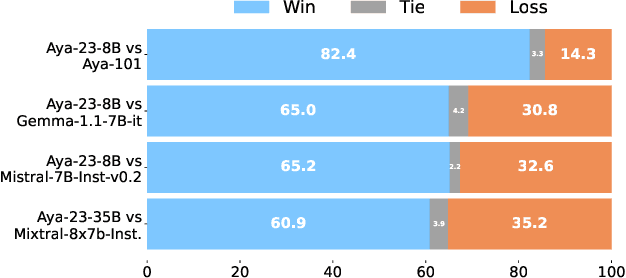

Abstract:This technical report introduces Aya 23, a family of multilingual language models. Aya 23 builds on the recent release of the Aya model (\"Ust\"un et al., 2024), focusing on pairing a highly performant pre-trained model with the recently released Aya collection (Singh et al., 2024). The result is a powerful multilingual large language model serving 23 languages, expanding state-of-art language modeling capabilities to approximately half of the world's population. The Aya model covered 101 languages whereas Aya 23 is an experiment in depth vs breadth, exploring the impact of allocating more capacity to fewer languages that are included during pre-training. Aya 23 outperforms both previous massively multilingual models like Aya 101 for the languages it covers, as well as widely used models like Gemma, Mistral and Mixtral on an extensive range of discriminative and generative tasks. We release the open weights for both the 8B and 35B models as part of our continued commitment for expanding access to multilingual progress.
Back to Basics: Revisiting REINFORCE Style Optimization for Learning from Human Feedback in LLMs
Feb 26, 2024Abstract:AI alignment in the shape of Reinforcement Learning from Human Feedback (RLHF) is increasingly treated as a crucial ingredient for high performance large language models. Proximal Policy Optimization (PPO) has been positioned by recent literature as the canonical method for the RL part of RLHF. However, it involves both high computational cost and sensitive hyperparameter tuning. We posit that most of the motivational principles that led to the development of PPO are less of a practical concern in RLHF and advocate for a less computationally expensive method that preserves and even increases performance. We revisit the formulation of alignment from human preferences in the context of RL. Keeping simplicity as a guiding principle, we show that many components of PPO are unnecessary in an RLHF context and that far simpler REINFORCE-style optimization variants outperform both PPO and newly proposed "RL-free" methods such as DPO and RAFT. Our work suggests that careful adaptation to LLMs alignment characteristics enables benefiting from online RL optimization at low cost.
Aya Model: An Instruction Finetuned Open-Access Multilingual Language Model
Feb 12, 2024



Abstract:Recent breakthroughs in large language models (LLMs) have centered around a handful of data-rich languages. What does it take to broaden access to breakthroughs beyond first-class citizen languages? Our work introduces Aya, a massively multilingual generative language model that follows instructions in 101 languages of which over 50% are considered as lower-resourced. Aya outperforms mT0 and BLOOMZ on the majority of tasks while covering double the number of languages. We introduce extensive new evaluation suites that broaden the state-of-art for multilingual eval across 99 languages -- including discriminative and generative tasks, human evaluation, and simulated win rates that cover both held-out tasks and in-distribution performance. Furthermore, we conduct detailed investigations on the optimal finetuning mixture composition, data pruning, as well as the toxicity, bias, and safety of our models. We open-source our instruction datasets and our model at https://hf.co/CohereForAI/aya-101
Aya Dataset: An Open-Access Collection for Multilingual Instruction Tuning
Feb 09, 2024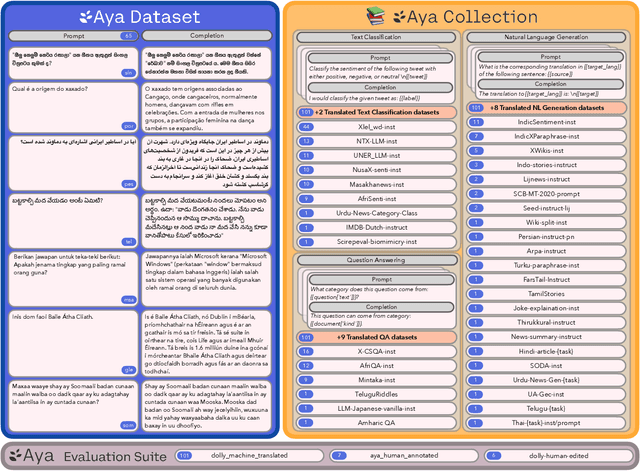
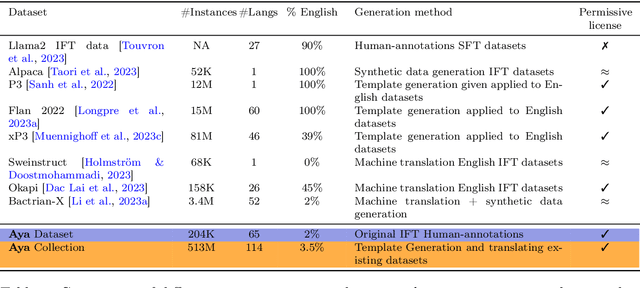
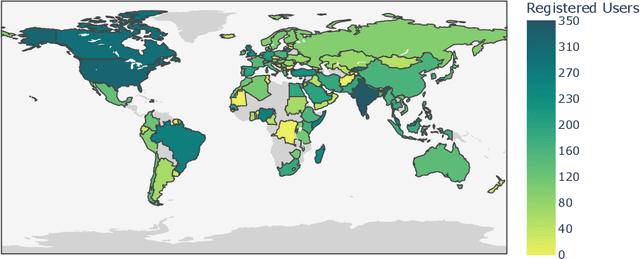
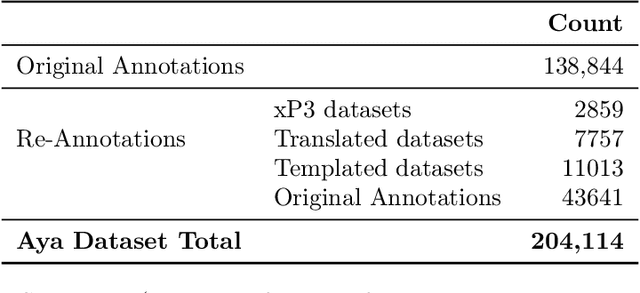
Abstract:Datasets are foundational to many breakthroughs in modern artificial intelligence. Many recent achievements in the space of natural language processing (NLP) can be attributed to the finetuning of pre-trained models on a diverse set of tasks that enables a large language model (LLM) to respond to instructions. Instruction fine-tuning (IFT) requires specifically constructed and annotated datasets. However, existing datasets are almost all in the English language. In this work, our primary goal is to bridge the language gap by building a human-curated instruction-following dataset spanning 65 languages. We worked with fluent speakers of languages from around the world to collect natural instances of instructions and completions. Furthermore, we create the most extensive multilingual collection to date, comprising 513 million instances through templating and translating existing datasets across 114 languages. In total, we contribute four key resources: we develop and open-source the Aya Annotation Platform, the Aya Dataset, the Aya Collection, and the Aya Evaluation Suite. The Aya initiative also serves as a valuable case study in participatory research, involving collaborators from 119 countries. We see this as a valuable framework for future research collaborations that aim to bridge gaps in resources.
Intriguing Properties of Compression on Multilingual Models
Nov 04, 2022



Abstract:Multilingual models are often particularly dependent on scaling to generalize to a growing number of languages. Compression techniques are widely relied upon to reconcile the growth in model size with real world resource constraints, but compression can have a disparate effect on model performance for low-resource languages. It is thus crucial to understand the trade-offs between scale, multilingualism, and compression. In this work, we propose an experimental framework to characterize the impact of sparsifying multilingual pre-trained language models during fine-tuning. Applying this framework to mBERT named entity recognition models across 40 languages, we find that compression confers several intriguing and previously unknown generalization properties. In contrast to prior findings, we find that compression may improve model robustness over dense models. We additionally observe that under certain sparsification regimes compression may aid, rather than disproportionately impact the performance of low-resource languages.
 Add to Chrome
Add to Chrome Add to Firefox
Add to Firefox Add to Edge
Add to Edge